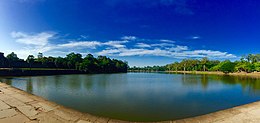Siem Reap
សៀមរាប | |
|---|---|
| Siem Reap Province ខេត្តសៀមរាប | |
| Nickname: Gateway to Angkor | |
 Map of Cambodia highlighting Siem Reap | |
| Coordinates: 13°21′N 103°51′E / 13.350°N 103.850°E | |
| Country | |
| Settled | 802 |
| Provincial status | 23 December 1907[1] |
| Capital | Siem Reap |
| Subdivisions | 2 municipalities; 11 districts |
| Government | |
| • Governor | Prak Sophoan (CPP) |
| • National Assembly | 6 / 125
|
| Area | |
| • Total | 10,299 km2 (3,976 sq mi) |
| • Rank | 10th |
| Population (2023)[2] | |
| • Total | |
| • Rank | 4th |
| • Density | 98/km2 (250/sq mi) |
| • Rank | 13th |
| Time zone | UTC+07:00 (ICT) |
| ISO 3166 code | KH-17 |
| Website | www |
Siem Reap, officially Siemreap[3] (Khmer: សៀមរាប [siəm riəp], lit. 'Siam's Defeated'), is a province (khaet) of Cambodia. It borders the provinces of Oddar Meanchey to the north, Preah Vihear and Kampong Thom to the east, Battambang to the south, and Banteay Meanchey to the west. Its capital and largest city is Siem Reap.
Siem Reap province is the tenth largest province in Cambodia. Having reached a population of one million in 2019, it ranks as the nation's fourth most populous province.[2] A large portion of Siem Reap province's southern border is demarcated by the Tonle Sap and as such, it is one of the nine provinces that making up the Tonle Sap Biosphere Reserve. In modern times the province is best known as the site of Angkor and the Angkor Wat temple ruins, a UNESCO World Heritage Site. It is also the home of Banteay Srei, Roluos (temples), the UNESCO tentative site of Beng Mealea, and the UNESCO tentative site of Phnom Kulen National Park, home to the country's largest reclining Buddha.
- ^ "History of Siem Reap". siemreap.gov.kh. Archived from the original on 18 July 2019. Retrieved 17 August 2019.
- ^ a b "General Population Census of the Kingdom of Cambodia 2019 – Final Results" (PDF). National Institute of Statistics. Ministry of Planning. 26 January 2021. Retrieved 3 February 2021.
- ^ "Geographical Names of the Kingdom of Cambodia" (PDF). UNSTATS. Eighth United Nations Conference on the Standardization of Geographical Names. 29 August 2002. Retrieved 7 June 2019.




